经典经济学入门教材英文讲义1(Principles of Economic)
曼昆《经济学原理》讲座讲义(英文)
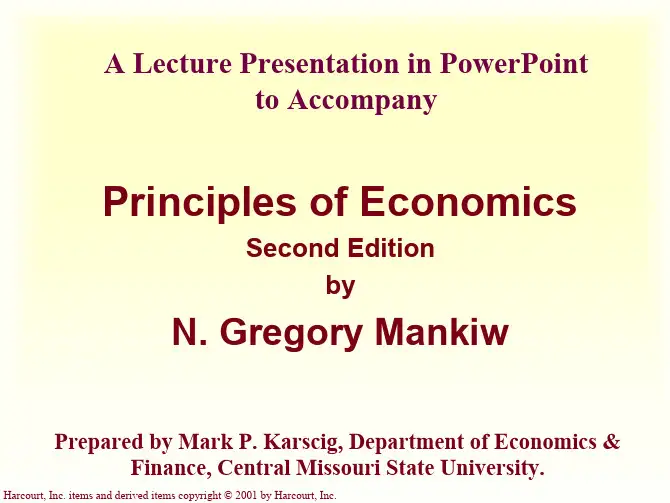
Harcourt, Inc. items and derived items copyright © 2001 by Harcourt, Inc.
4. People respond to incentives.
Marginal changes in costs or benefits motivate people to respond. The decision to choose one alternative over another occurs when that alternative’s marginal benefits exceed its marginal costs!
Ten Principles of Economics
How People Make Decisions
People face tradeoffs. The cost of something is what you give up to get it. Rational people think at the margin. People respond to incentives.
Harcourt, Inc. items and derived items copyright © 2001 by Harcourt, Inc.
6. Markets are usually a good way to organize economic activity.
Because households and firms look at prices when deciding what to buy and sell, they unknowingly take into account the social costs of their actions. As a result, prices guide decision makers to reach outcomes that tend to maximize the welfare of society as a whole.
principles of economic第一章读后感
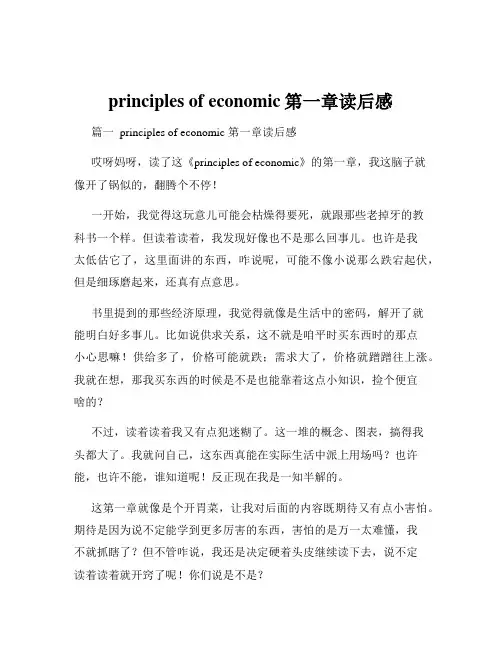
principles of economic第一章读后感篇一 principles of economic 第一章读后感哎呀妈呀,读了这《principles of economic》的第一章,我这脑子就像开了锅似的,翻腾个不停!一开始,我觉得这玩意儿可能会枯燥得要死,就跟那些老掉牙的教科书一个样。
但读着读着,我发现好像也不是那么回事儿。
也许是我太低估它了,这里面讲的东西,咋说呢,可能不像小说那么跌宕起伏,但是细琢磨起来,还真有点意思。
书里提到的那些经济原理,我觉得就像是生活中的密码,解开了就能明白好多事儿。
比如说供求关系,这不就是咱平时买东西时的那点小心思嘛!供给多了,价格可能就跌;需求大了,价格就蹭蹭往上涨。
我就在想,那我买东西的时候是不是也能靠着这点小知识,捡个便宜啥的?不过,读着读着我又有点犯迷糊了。
这一堆的概念、图表,搞得我头都大了。
我就问自己,这东西真能在实际生活中派上用场吗?也许能,也许不能,谁知道呢!反正现在我是一知半解的。
这第一章就像是个开胃菜,让我对后面的内容既期待又有点小害怕。
期待是因为说不定能学到更多厉害的东西,害怕的是万一太难懂,我不就抓瞎了?但不管咋说,我还是决定硬着头皮继续读下去,说不定读着读着就开窍了呢!你们说是不是?嘿,朋友们!今天我要跟你们唠唠我读《principles of economic》第一章的那些事儿。
刚翻开这书的时候,我心里直犯嘀咕:“这能有意思吗?”可没想到,读着读着,我居然被吸引住了。
就好像走进了一个全新的世界,到处都是我不懂但又好奇得不行的东西。
这第一章里讲的经济原理,让我有种恍然大悟的感觉。
比如说,那个机会成本的概念,我以前可从来没想过。
做一件事的时候,可能放弃了做另一件事的机会,这放弃的就是机会成本。
我就想啊,我平时做决定的时候,是不是根本没考虑到这一点呢?也许我错过了好多更好的选择,自己还不知道呢!但是,这里面有些东西也太难懂啦!那些复杂的公式和图表,看得我眼花缭乱。
商业经济学英文教材
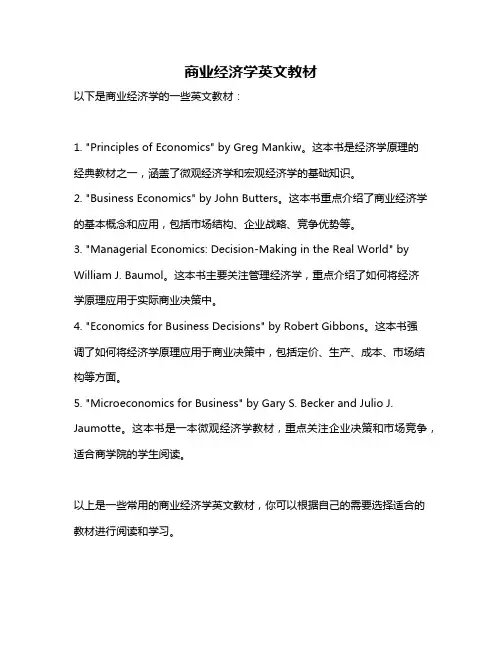
商业经济学英文教材
以下是商业经济学的一些英文教材:
1. "Principles of Economics" by Greg Mankiw。
这本书是经济学原理的
经典教材之一,涵盖了微观经济学和宏观经济学的基础知识。
2. "Business Economics" by John Butters。
这本书重点介绍了商业经济学的基本概念和应用,包括市场结构、企业战略、竞争优势等。
3. "Managerial Economics: Decision-Making in the Real World" by William J. Baumol。
这本书主要关注管理经济学,重点介绍了如何将经济
学原理应用于实际商业决策中。
4. "Economics for Business Decisions" by Robert Gibbons。
这本书强
调了如何将经济学原理应用于商业决策中,包括定价、生产、成本、市场结构等方面。
5. "Microeconomics for Business" by Gary S. Becker and Julio J. Jaumotte。
这本书是一本微观经济学教材,重点关注企业决策和市场竞争,适合商学院的学生阅读。
以上是一些常用的商业经济学英文教材,你可以根据自己的需要选择适合的教材进行阅读和学习。
【经济学(双语)】【PrinciplesofEconomics】
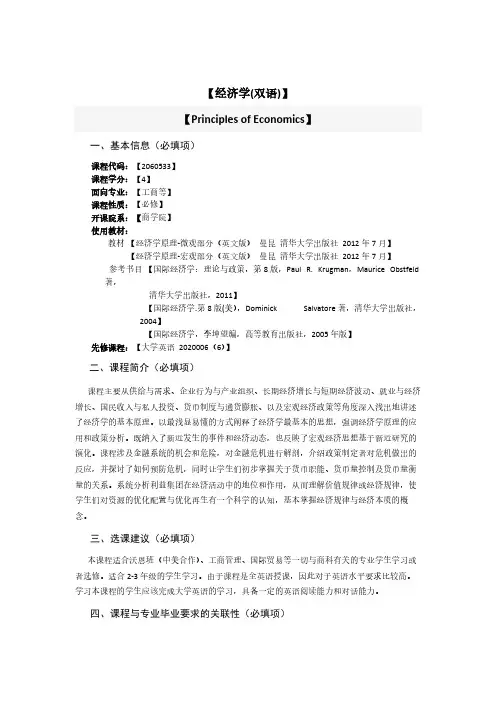
LO36 项目管理能力。熟悉项目范围、项目时间、项目成本、项目质量、项目人员、 项目沟通、项目风险、项目采购、项目集成管理等。
指标点
LO361 熟悉项目范围、项目时间、项目成本、项目质量、项目人员 LO362 掌握项目策划、项目风险、项目采购 LO363 掌握项目集成管理
LO37 商务策划能力。能用已有的思维成果和创新的方法进行策划。熟悉营销策划原
编号 能力
毕业要求和指标点
LO11 理解他人的观点,尊重他人的观点,能在不同场合用书面或口头形式进行有效
沟通。
表达
LO1
沟通
LO111 倾听他人意见、尊重他人观点、分析他人需求。
指标点
LO112 应用书面或口头形式,阐释自己的观点,有效沟通。
LO21 学生能根据环境需要确定自己的学习目标,并主动地通过搜集信息、分析信
●
尽责 LO4
L0412 诚实守信:为人诚实,信守承诺,尽职尽责。
●
抗压
LO413 爱岗敬业:了解与专业相关的法律法规,充分认识本专业就业岗位
指标点
在社会经济中的作用和地位,在学习和社会实践中遵守职业规范,具备职
业道德操守。
LO414 身心健康,能承受学习和生活中的压力。
LO51 同群体保持良好的合作关系,做集体中的积极成员;善于从创新思维,利用自 己的知识与实践来提出新设想。
1.3.10 Society Faces a Short-run Tradeoff Between Inflation and Unemployment 能力要求:
知道: What is Economy 理解: What is Economics 分析: Market-based / Command-based economy 综合: Ten Principles of Economics 教学重点: Ten Principles of Economics Definition of economy and economics
Theprinciplesofeconomics.经济学的原理(英译中)
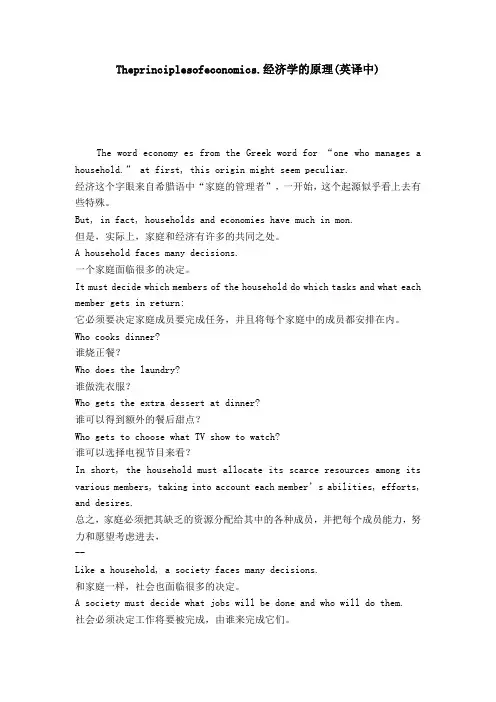
Theprinciplesofeconomics.经济学的原理(英译中)The word economy es from the Greek word for “one who manages a household.” at first, this origin might seem peculiar.经济这个字眼来自希腊语中“家庭的管理者”,一开始,这个起源似乎看上去有些特殊。
But, in fact, households and economies have much in mon.但是,实际上,家庭和经济有许多的共同之处。
A household faces many decisions.一个家庭面临很多的决定。
It must decide which members of the household do which tasks and what each member gets in return:它必须要决定家庭成员要完成任务,并且将每个家庭中的成员都安排在内。
Who cooks dinner?谁烧正餐?Who does the laundry?谁做洗衣服?Who gets the extra dessert at dinner?谁可以得到额外的餐后甜点?Who gets to choose what TV show to watch?谁可以选择电视节目来看?In short, the household must allocate its scarce resources among its various members, taking into account each member’s abilitie s, efforts, and desires.总之,家庭必须把其缺乏的资源分配给其中的各种成员,并把每个成员能力,努力和愿望考虑进去,--Like a household, a society faces many decisions.和家庭一样,社会也面临很多的决定。
第一讲 什么是经济学
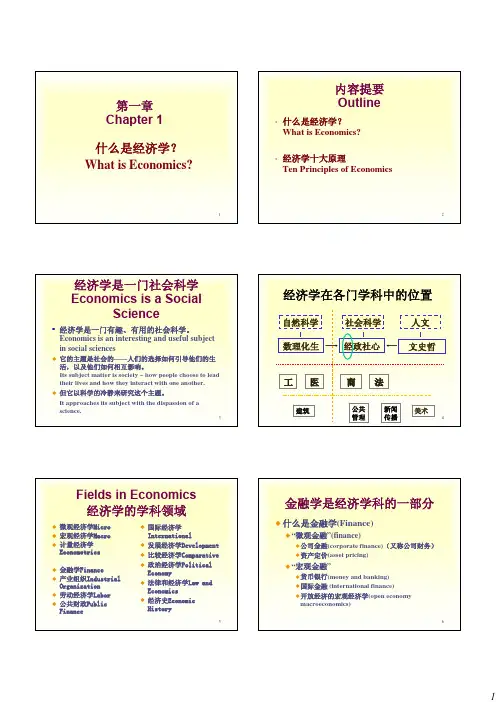
“许多实行家自以为不受任何学理的影响,却往往当了某 个已故经济学的奴隶”
“The ideas of economists and political philosophers, both when they are right and when they are wrong, are more powerful than is commonly understood. Indeed, the world is ruled by little else. Practical men, who believe themselves to be quite exempt from intellectual influences, are usually the slaves of some defunct economists.”
20
经济学的三类问题
1. 人们如何作出决策 How People Make Decisions
2. 人们如何相互作用 How People Interact
3. 整体经济如何运行 How the Economy as a Whole Works
21
经济学的十个原理
人们如何作出决策
How People Make Decisions
• 训练经济学直觉 To gain economic intuition
13
经济学三个层次的特点
经济学原理不用公式而用图表(“curveshifting economics”)
入门课 三个主要目的
中级经济学用一些数学和统计
较为严格的数学推理 较为系统的经验实证分析
高级经济学用很多数学(“Greek-letter economics”)
经济管理类的经典书籍
经济管理类的经典书籍经济管理类的经典书籍是帮助读者深入了解经济学与管理学原理的重要工具。
这些书籍涵盖了从经济学基础知识到管理理论和实践的广泛范围。
在这篇文章中,我们将介绍五本经典的经济管理类书籍。
1.《经济学原理》(Principles of Economics)- N. Gregory Mankiw《经济学原理》是一本经济学入门的经典教材。
著名的经济学家Mankiw以清晰、易懂的语言介绍了经济学的基本概念和原理。
书中讨论了供求关系、市场结构、税收和政府政策等重要主题。
这本书特别适合那些对经济学感兴趣,但没有相关背景知识的读者。
2.《管理学》(Management)- Stephen P. Robbins & Mary Coulter《管理学》是一本全面介绍管理学知识和实践的经典教材。
该书涵盖了组织行为、领导、决策、沟通、团队管理等关键内容。
作者通过实际案例和具体的管理经验,帮助读者理解和应用管理理论。
这本书适合希望在管理领域找到成功的专业人士和学生。
3.《创新者的窘境》(The Innovator's Dilemma)- Clayton M. Christensen《创新者的窘境》是一本关于创新和经济变革的经典著作。
克莱顿·克里斯坦森(Clayton M. Christensen)教授通过研究行业颠覆与企业成功的案例,探讨了创新中的困境和挑战。
这本书提供了对企业如何在面对不断变化的市场中生存和发展的深入思考。
4.《财富的五种境界》(The Five Levels of Economic Development)- Martin Zesmelis《财富的五种境界》是一本强调经济发展的重要性的书籍。
马丁·泽斯梅利斯(Martin Zesmelis)在书中分析了五个经济发展阶段:生存、稳定、积累、财富和盈亏平衡。
通过对这些阶段的深入理解,读者可以更好地规划个人和组织的经济发展策略。
经济学原理讲义-英文
• Market power
– Ability of a single economic actor (or small group of actors) to have a substantial influence on market prices
– Size of the economic pie
• Equality
– Distributing economic prosperity uniformly among the members of society
– How the pie is divided into individual slices
15
How People Interact
Principle 7: Governments can sometimes improve market outcomes
• We need government
– Enforce rules and maintain institutions
• Enforce property rights
– Limited supplies – Surging demand from robust world
growth – Price of gasoline in the United States
rose from about $2 to about $4 a gallon
10
The Incentive Effects of Gasoline Prices
– Government intervention: Public policies
Chap_01导言(经济学原理,曼昆,中英文双语)
1. People face tradeoffs. 人们面临权衡取舍
“There is no such thing as a free lunch!” 天下没有免费的午餐
经济学——研究社会如何管理自己的稀
缺资源的学科。
Harcourt, Inc. items and derived items copyright © 2001 by Harcourt, Inc.
Economists study. . . 经济学家研究…
How
people make decisions.
LA Laker basketball star Kobe Bryant chose to skip college and go straight from high school to the pros where he has earned millions of dollars.
1. People face tradeoffs. Efficiency v. Equity
Efficiency
means society gets the most that it can from its scarce resources. Equity means the benefits of those resources are distributed fairly among the members of society.
Harcourt, Inc. items and derived items copyright © 2001 by Harcourt, Inc.
Chapter 1 Ten Principles of Economics
1Ten Principles of Economics1Ten Principles of Economics •Economy, “oikonomos” (Greek)–“One who manages a household”–Households and economies have much in common •Households face many decisions–Allocate scarce resources•Ability, effort, and desire•An economy consists of–the economic systems of a country or other area, the labor,capital and land resources, and the economic agents thatsocially participate in the production, exchange, distribution,and consumption of goods and services of that area.2Ten Principles of Economics•Resources are scarce•Scarcity–The limited nature of society’s resources–Society has limited resources and therefore cannotproduce all the goods and services people wish to have •Economics–is the social science concerned with how individuals,institutions, and society make optimal choices underconditions of scarcity.•Microeconomics and Macroeconomics3Scoring Components1.The course provides instruction in basic economic concepts and promotes understandingof economic decision-making factors,such as marginal analysis and opportunity costs.2.The course provides instruction in the nature and functions of product markets:Supply andDemand Model.3.The course provides instruction in the nature and functions of product markets:ConsumerChoice.4.The course provides instruction in the nature and functions of product markets:Productionand Costs.5.The course provides instruction in the nature and functions of product markets:MarketStructures.6.The course provides instruction in factor markets.7.The course provides instruction in market failure and the role of government in correctingmarket failure.8.The course teaches students how to generate graphs and charts to describe economicconcepts.9.The course teaches students how to interpret and analyze graphs, charts, and data todescribe economic concepts.4tigers seals Asian elephantsmonkeys What animals did you choose and why?This would have taken care of 7 of the 25 acres. 18 more to go.camelsCuddly tigers anyone?some core concepts of economics6Why didn’t you choose all the animals?Not enough land = lack of resources = scarcityWhy didn’t you choose cows or pigs?Benefit versus Costs (in terms of acres)Why didn’t you choose to fill your zoo with just monkeys or just tigers?Diminishing marginal utilityWhy did you choose an Asian Elephant rather than an African one?Benefit versus costsmore core concepts of economics7Which was the final animal you chose?Marginal AnalysisWhat animal just missed out on being chosen for your zoo?Opportunity Cost –the cost of the best alternative foregoneIf this was a group exercise would the choices have been the same?Individual benefits versus Social benefitsTen Principles of Economics•Economists study:–How people make decisions•Work, buy, save, invest–How people interact with one another–Analyze forces and trends that affect the economy as awhole•Growth in average income•Fraction of the population that cannot find work•Rate at which prices are rising8Ten Principles of Economics•How people make decisions1.People face trade-offs2.The cost of something is what you give up to get it3.Rational people think at the margin4.People respond to incentives9Ten Principles of Economics•How people interact5.Trade can make everyone better off6.Markets are usually a good way to organize economicactivityernments can sometimes improve market outcomes10Ten Principles of Economics•How the economy as a whole works8.A country’s standard of living depends on its ability toproduce goods and services9.Prices rise when the government prints too much money10.Society faces a short-run trade-off between inflation andunemployment11How People Make Decisions, #1Principle 1: People face trade-offs•“There ain’t no such thing as a free lunch”–To get something that we like, we usually have to give up something else that we also like•Making decisions–Trade off one goal against another•People face choices all the time.12How People Make Decisions, #1•Trade offs–Students: time–Parents: income–Society•National defense vs. consumer goods (guns vs. butter)•Clean environment vs. high level of income•Efficiency vs. equality13How People Make Decisions, #1•Efficiency–Society getting the maximum benefits from its scarceresources–Size of the economic pie•Equality–Distributing economic prosperity uniformly among themembers of society–How the pie is divided into individual slices14How People Make Decisions, #2Principle 2: The cost of something is what you give up to get it •People face trade-offs–Make decisions•Compare cost with benefits of alternatives•Opportunity cost–Whatever must be given up to obtain some item–Opportunity cost always exists as long as people make achoice.–Absolute advantage–Comparative advantage15How People Make Decisions, #3Principle 3: Rational people think at the margin•Rational people–Systematically and purposefully do the best they can toachieve their objectives•Marginal changes–Small incremental adjustments to a plan of action16How People Make Decisions, #3•Optimal decision–rational people think at the margin (not the average).•Rational decision maker–Make decisions by comparingmarginal benefits and marginalcosts–Take action only if: •Marginal benefits > Marginal costs 17“Is the marginal benefit of this call greater thanthe marginal cost?”How People Make Decisions, #4Principle 4: People respond to incentives•Incentive–Something that induces a person to act–Higher price•Buyers -consume less•Sellers -produce more–Public policy•Change costs or benefits•Change people’s behavior18The Incentive Effects of Gasoline Prices•2005 to 2008, price of oil in world oilmarkets skyrocketed–Limited supplies–Surging demand from robust worldgrowth–Price of gasoline in the United Statesrose from about $2 to about $4 a gallon19The Incentive Effects of Gasoline Prices•Increased incentive to conserve gas–Smaller cars, scooters, bicycles, masstransit–Camels (India)–New, more fuel-efficient aircraft•Airbus A320 and Boeing 737–Moving near an Amtrak station–Online courses20How People Interact, #5Principle 5: Trade can makeeveryone better off•Trade–Allows each person tospecialize in the activities he or she does best–Enjoy a greater variety ofgoods and services at lowercost–People need self-sufficiencywithout trade 21“For $5 a week you can watch baseball without being nagged to cut the grass!”How People Interact, #6Principle 6: Markets are usually a good way to organize economic activity•Communist countries, central planning–Government officials (central planners)•Allocate economy’s scarce resources–What goods and services were produced–How much was produced–Who produced and consumed these goods and services22How People Interact, #6•Market economy, allocation of resources–Through decentralized decisions of many firms andhouseholds–As they interact in markets for goods and services–Guided by prices and self-interest23How People Interact, #6•Adam Smith’s “invisible hand”–Households and firms interacting in markets•Act as if they are guided by an “invisible hand”•Leads them to desirable market outcomes–Corollary: Government intervention•Prevents the invisible hand’s ability to coordinate the decisionsof the households and firms that make up the economy24How People Interact, #7Principle 7: Governments can sometimes improve market outcomes•We need government–Enforce rules and maintain institutions that are key to amarket economy–Enforce property rights–Promote efficiency, avoid market failure–Promote equality, avoid disparities in economic wellbeing25How People Interact, #7•Property rights–Ability of an individual to own and exercise control overscarce resources•Market failure–Situation in which the market left on its own fails toallocate resources efficiently–Externalities–Market power26How People Interact, #7•Externality–Impact of one person’s actions on the well-being of abystander–Pollution•Market power–Ability of a single economic actor (or small group ofactors) to have a substantial influence on market prices27How People Interact, #7•Disparities in economic wellbeing–Market economy rewards people•According to their ability to produce things that other people arewilling to pay for–Government intervention, public policies•Aim to achieve a more equal distribution of economic well-being•May diminish inequality•Process far from perfect28How the Economy as a Whole Works, #8 Principle 8: A country’s standard of living depends on its ability to produce goods and services•Large differences in living standards–Among countries–Over time•Average annual income, 2011–$48,000 (U.S.); $9,000 (Mexico)–$5,000 (China); $1,200 (Nigeria)29How the Economy as a Whole Works, #8•Explanation: differences in productivity•Productivity–Quantity of goods and services produced from each unit of labor input–Higher productivity•Higher standard of living–Growth rate of nation’s productivity•Determines growth rate of its average income30How the Economy as a Whole Works, #9Principle 9: Prices rise when the government prints too muchmoney•Inflation–An increase in the overall level of prices in the economy •Causes for large or persistent inflation –Growth in quantity of money –Value of money falls31“Well it mayhave been 68cents when yougot in line, butit’s 74 centsnow!”How the Economy as a Whole Works, #10 Principle 10: Society faces a short-run trade-off between inflation and unemployment•Short-run effects of monetary injections:–Stimulates the overall level of spending•Higher demand for goods and services–Firms –raise prices; hire more workers; produce moregoods and services–Lower unemployment32How the Economy as a Whole Works, #10•Short-run trade-off between unemployment and inflation –Key role –analysis of business cycle•Business cycle–Fluctuations in economic activity•Employment•Production33Table 134Ten Principles of Economics。
- 1、下载文档前请自行甄别文档内容的完整性,平台不提供额外的编辑、内容补充、找答案等附加服务。
- 2、"仅部分预览"的文档,不可在线预览部分如存在完整性等问题,可反馈申请退款(可完整预览的文档不适用该条件!)。
- 3、如文档侵犯您的权益,请联系客服反馈,我们会尽快为您处理(人工客服工作时间:9:00-18:30)。
Branches of Economics
• Econometrics is the application of st atistics to the study of economic phe nomena
Economics Concepts
• Normative economics is the study of h ow economic systems are. • Positive economics is economic analys is which makes or supports policy rec ommendations
Lesson 1: Utility
Mankiw, pp. 460 – 464
Economics is„
• „the study of the production, distri bution, and consumption of goods and services.
• „the study of the division of finite resources given infinite wants • „a way of mathematically modeling ha ppiness
Branches of Economics
• Microeconomics is the study of how ho useholds and firms make decisions and how they interact in specific markets .
• Macroeconomics is the study of the ec onomy at the community, national, reg ional, or world level.
Goods and Bads Revisited
• If something is a good, then more of that thing increases utility. • dU/dx >0 implies that x is a good • If something is a bad, then more of t hat thing decreases utility • dU/dx<0 implies that x is a bad
Recent papers in economics (fro m American Economic Review , Se ptember 2009)
• “Can News about the Future Drive the Bu siness Cycle?” • “Why Do Sellers (Usually) Prefer Auctio ns?” • “Spousal Control and Intra-Household De cision Making: An Experimental Study in the Phillipines”
Assumptions
• Transitivity – If A is preferred to B, and B is preferred to C, then A is preferred to C.
• Continuity – If A is preferred to B, then situations “close to” A are pr eferred to B.
Example
• Suppose an individual’s utility is a function of rainy days and apples.
– Express this concept mathematically. – Which is likely to be a good and which is likely to be a bad? – Based on what we’ve learned so far, prop ose a utility function which makes sense. – Propose another utility function which is equivalent to this one.
are downward slop do not cross are convex (bowed
Sample Utility Functions
• Cobb-Douglass utility function
• Linear utility function • Leontief Utility function
Assumptions
• Completeness – Given any two situati ons, an individual can specify which is preferred to the other, or that sh e is indifferent between the two.
Perfect complements
• Goods for which indifference curves a re right-angled are perfect complemen ts.
• Example: right shoes and left shoes • Can be modeled with a Liontief utilit y function.
• Grthe i ndifference curve.
Perfect Substitutes
• Goods for which indifference curves a re straight lines are called perfect substitutes.
• Example: 500 won coins and 100 won co ins • Can be modeled with a linear utility function.
• Economics problems are generally stud ied ceteris paribus, which means “ev erything else being equal”
Assumptions of Utility Theor y
• People are rational – they optimally use all the information they have to maximize utility.
Monotonicity examples
• Suppose values of y and x must be pos itive. In all of the following, y is a monotonic transformation of x:
–y –y –y –y = = = = 2x x+4 x^2 ln(x)
Recent papers
• “One Chance in a Million: Altruism a nd the Bone Marrow Registry” • “The Effects of High Stakes High Sch ool Achievement Awards: Evidence from a Randomized Trial”
Economics concepts
• A closed economy is an economy which does not interact with other economie s outside itself.
• An open economy is an economy which d oes.
The Marginal Rate of Substituti on
• The marginal rate of substitution is the amount of one good that would com pensate for a marginal loss of anothe r good.
• A good is something which increases util ity. • A bad is something which decreases utili ty.
Utility notation
Ceteris Paribus
• In real life, a person’s utility is a function of at least thousands of f actors.
Usual Properties of Indifferenc e Curves for Two Goods
• Higher indifference red to lower ones • Indifference curves ing • Indifference curves • Indifference curves inward) curves are prefer
Indifference Curve Example
• Suppose the following quantities of loaves o f bread and liters milk all yield a utility of, say, 10: Bread Milk 0 10 1 7 2 5 3 4 6 0 • These points can be sketched out to form an indifference curve.
Utility Theory
• Utility is the degree of a preference an individual assigns to a state. If situa tion A is preferred to B, we say that A offers a higher utility than B.
